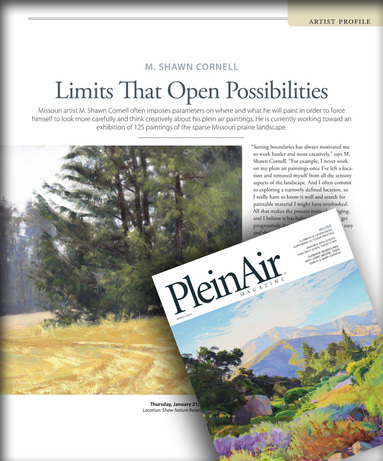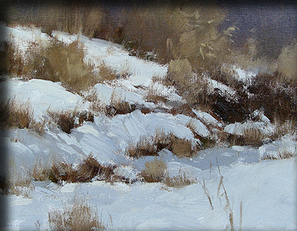I'm a Proud Member of Heartland Art Club

Painted 100% En Plein Air
For a painting to be considered “plein air,” standard thought is at least 75% of it be completed on location. However, in order for me to address my personal work as “plein air” it must be completed 100% on location.
I promise that all my paintings represented as “plein air” paintings were completed 100% on location. I will not designate a painting of mine “plein air” if it received any studio touch up.
Why make this claim? Simply because it’s a challenge and I want to see if it’s something I can accomplish. Just as some tightrope walkers choose not to use a net in case they fall, I’ve chosen not to use the safety net of, “I’ll fix the painting later” or “I’ll complete it when I get back to the studio.” Many of my paintings have fallen to their doom because of this decision, but again, it’s the challenge and desire to see if I can do it without the proverbial safety net.
All of my "plein air" paintings are stamped with my guarantee.
For a painting to be considered “plein air,” standard thought is at least 75% of it be completed on location. However, in order for me to address my personal work as “plein air” it must be completed 100% on location.
I promise that all my paintings represented as “plein air” paintings were completed 100% on location. I will not designate a painting of mine “plein air” if it received any studio touch up.
Why make this claim? Simply because it’s a challenge and I want to see if it’s something I can accomplish. Just as some tightrope walkers choose not to use a net in case they fall, I’ve chosen not to use the safety net of, “I’ll fix the painting later” or “I’ll complete it when I get back to the studio.” Many of my paintings have fallen to their doom because of this decision, but again, it’s the challenge and desire to see if I can do it without the proverbial safety net.
All of my "plein air" paintings are stamped with my guarantee.
The Story Behind the Painting - Literally
For me, painting "en plein air" is more than just creating two dimensional representations. It's my wife's companionship as she illuminates the canvas with a flashlight so I can paint the full moon. It's my dad and me sharing a thermos of hot cheesy tomato soup while we paint a frozen, snow covered stream. It's spending time to see the extraordinary in things many would call ordinary. It's a brief moment of life, captured on canvas.
Years ago, while talking to an artist at the Salute to the Masters Art Fair, I saw among his vast display a striking mountain landscape. When I asked him where the scene was, he replied, “I don’t know. I copied it from some magazine.” Instantly, the image died. To me, the painting became just a well rendered copy of some unknown printed copy from some unremembered magazine; it possessed no connections, no experiences and no life. I think that moment established in me a core conviction that my paintings would be witnesses and tributes to real experiences as they were happening. The paintings would be stories about brief moments in my life, told visually and narratively to whomever desired to look. Over the years, the implementing of this core conviction has supplied me with many frustrations, a multitude of close friends, and countless rewards.
And that's why the back of each painting is documented with its location, date, time of day, weather conditions, and brief observations about the day. Many have referred to this documentation as the painting's birth certificate. Also, I encourage anyone who acquires one of my paintings to continue it's story by adding their story to it's back by simply writing about how they came about the piece, placing it in an envelope and securing it to the back. My hope is that every future owner continues the story thereby, continuing the life of the painting.
Years ago, while talking to an artist at the Salute to the Masters Art Fair, I saw among his vast display a striking mountain landscape. When I asked him where the scene was, he replied, “I don’t know. I copied it from some magazine.” Instantly, the image died. To me, the painting became just a well rendered copy of some unknown printed copy from some unremembered magazine; it possessed no connections, no experiences and no life. I think that moment established in me a core conviction that my paintings would be witnesses and tributes to real experiences as they were happening. The paintings would be stories about brief moments in my life, told visually and narratively to whomever desired to look. Over the years, the implementing of this core conviction has supplied me with many frustrations, a multitude of close friends, and countless rewards.
And that's why the back of each painting is documented with its location, date, time of day, weather conditions, and brief observations about the day. Many have referred to this documentation as the painting's birth certificate. Also, I encourage anyone who acquires one of my paintings to continue it's story by adding their story to it's back by simply writing about how they came about the piece, placing it in an envelope and securing it to the back. My hope is that every future owner continues the story thereby, continuing the life of the painting.
“Missouri Prairies en Plein Air”
“Missouri Prairies en Plein Air” was a solo exhibit at the Albrecht-Kemper Museum of Art from November 20, 2015 thru January 10, 2016. It contained 128 paintings documenting Missouri’s prairies throughout all four seasons, various times of day and night, in a variety of weather conditions, along with images of controlled prairie burns, close-up intimate scenes, and vast views, all completed 100% en plein air. When imagining a prairie, the scene that materializes in many minds is a vast open space that consists of sky and horizon. My goal was to capture on canvas the far more diverse range of settings and beauty our prairies possess beyond that simple horizon line.
Plein Air Magazine's Artist Profile ArticleLimits That Open Possibilities by Stephen Doherty
Missouri artist M. Shawn Cornell often imposes parameters on where and what he will paint in order to force himself to look more carefully and think creatively about his plein air paintings. “Setting boundaries has always motivated me to work harder and more creatively,” says M. Shawn Cornell. “For example, I never work on my plein air paintings once I’ve left a location and removed myself from all the sensory aspects of the landscape. And I often commit to exploring a narrowly defined location so I really have to know it well and search for paintable material I might have overlooked. All that makes the process more challenging, and I believe it has helped my paintings get progressively better because I avoided the... |



